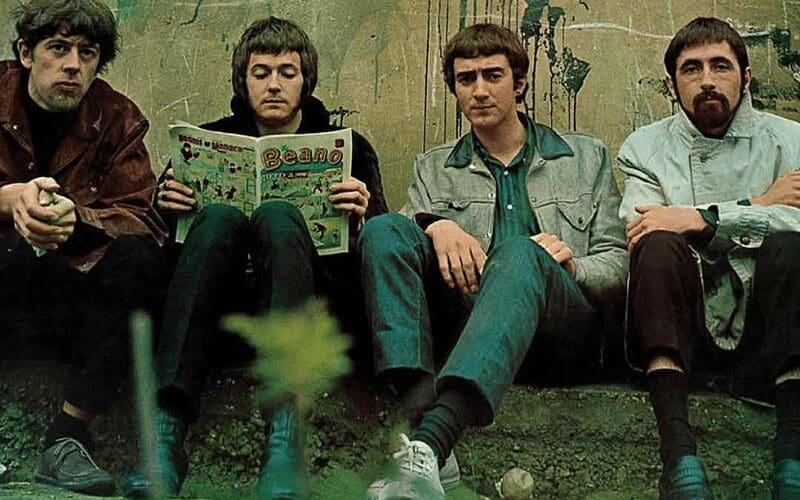John Mayall’s ‘Finishing School’ for Young British Blues-Rock Musicians
John Mayall, ‘Godfather of British Blues,’ is dead at 90.
John Mayall, the multi-instrumentalist who pioneered a unique style of blues harmonica playing, is perhaps better known for being an incubator for young musical talent through his various Bluesbreakers lineups. He died last Monday (July 22) at the age of 90.
Mayall became immersed in the blues in the ’50s in rural England by listening to his father’s extensive record collection (John eventually had a formidable collection of his own). “Anything with the word ‘boogie’ on it, I bought it,” Mayall told the LA Times.
By the early ’60s, Mayall moved to London and joined fellow blues enthusiasts Alexis Korner and Cyril Davies to form the core of British blues. In 1963 he founded John Mayall and the Bluesbreakers and beckoned British blues-rock musicians on the rise. Many of them cycled through the Bluesbreakers to become stars in their own right.
Eric Clapton and the ‘Beano’ Album

Band photo of John Mayall and the Bluesbreakers with Eric Clapton. From L-R: John Mayall, Eric Clapton, John McVie, and Hughie Flint. Source: Deram/Decca
In 1965, John Mayall recruited a young guitarist named Eric Clapton. Mayall probably saw a kindred spirit in Clapton, a blues purist. The two commenced recording an album brimming with their favorite blues standards. Clapton had two solo instrumental songs, elevating his blues guitar cred.
John Mayall & the Bluesbreakers with Eric Clapton, released on July 22, 1966, is remembered as “the Beano album,” as the above image reveals why.
The album gave us a glimpse of Mayall’s unique, virtuoso blues harmonica playing: quick, rhythmic, and chord-percussive. Here is Little Walter’s “It Ain’t Right,” published by John Mayall via YouTube:
The Beano album was still being shipped to record stores when Clapton quit John Mayall’s Bluesbreakers to join the supergroup Cream. But for Mayall, his “finishing school’ was just getting started.
Peter Green
Mike Vernon, a producer for Decca Records, recalled how John Mayall was impressed with his new guitarist:
…so I said to John Mayall, ‘Where’s Eric Clapton?’ Mayall answered, ‘He’s not with us anymore, he left us a few week ago.’ I was in a shock of state [sic] but Mayall said, ‘Don’t worry, we’ve got someone better.’ I said, ‘Wait a minute, hang on, this is ridiculous. You’ve got someone better than Eric Clapton?’ John said, ‘He might not be right now but you wait, in a couple of years he’s going to be the best.’
Vernon’s incredulity was understandable. Eric Clapton had achieved cult-like status among guitar aficionados, as the “Clapton is God” graffiti in London’s Underground attested. Peter Green had to endure the “Where’s Eric?” catcalls in his early live appearances with the Bluesbreakers.
But Peter Green answered his detractors with the February 1967 release of A Hard Road, the second studio album of John Mayall & the Bluesbreakers. The album featured two Peter Green compositions, The Same Way” and Green’s instrumental magnum opus, “The Super-Natural.” Green fans started calling him “the Green God,” a sly reference to the Clapton graffiti.
Peter Green moved on in late 1967 to form Fleetwood Mac, taking along Bluesbreakers bassist John McVie and drummer Mick Fleetwood. It was Green who named the band after its rhythm section.
Mick Taylor
With Green gone, John Mayall went fishing for a new guitar the old-fashioned way: He placed a “Guitarist Wanted” ad in the weekly Melody Maker. Mick Taylor at the tender age of 17 answered the ad and got the job. Taylor praised John Mayall in a recent interview in Classic Rock:
It was quite a nerve-wracking experience when I was very young, following in the footsteps of Eric Clapton and Peter Green, but after a month or two I fitted in really well. It basically all came down to John Mayall’s stewardship and everything I learned from him about the blues. Travelling around with him in America made me a good blues player and I developed my own style…It was incredible.

The Bluesbreakers in 1967. From left: Mick Taylor, Chris Mercer, Keith Tillman, Keef Hartley, Dick Heckstall-Smith, and Mayall. Photo by Ivan Keeman/Redferns via Getty Images & NY Times.
Taylor played guitar on three Bluesbreakers albums: Crusade, Bare Wires, and Blues From Laurel Canyon. Like his predecessors, Taylor went on to bigger and better things. He joined The Rolling Stones in 1969, replacing Brian Jones.
The Turning Point
As the ’60s concluded, John Mayall moved to California and began experimenting with an entirely new sound: a “Jazz-Blues” fusion, no drums, with the lead guitar turned down and less prominent. On July 12, 1969, at the Filmore East in New York City, Mayall recorded a live album that put his new sound on vivid display.
The album The Turning Point featured a captivating blues harmonica performance in the song, “Room to Move,” which transformed into a unique “mouth percussion.” Here is a video that memorializes that performance, with excellent graphics, published by retiredcanadian via YouTube:
Roll Call
Here is a partial list of British and American musicians who more or less started their careers under John Mayall’s tutelage and then found success in their own right.
Eric Clapton, guitar
Peter Green, guitar
Mick Taylor, guitar
Harvey Mandel, guitar
Coco Montoya, guitar
Jon Mark, acoustic guitar
John McVie, bass
Larry Taylor, bass
Aynsley Dunbar, drums
Mick Fleetwood, drums
Keef Hartley, drums
Don “Sugarcane” Harris, violin
Blue Mitchell, trumpet
Johnny Almond, saxophone & flute
Coda
In a storied recording career that began in 1963, John Mayall released 38 studio albums, 34 live albums, 24 compilations, and 44 singles. The Beano album and The Turning Point were certified Gold. Mayall is a 2024 inductee into the Rock & Roll Hall of Fame.

















































































































